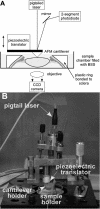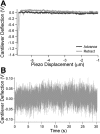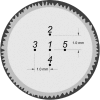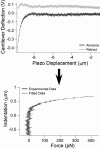Atomic force microscopy measurements of lens elasticity in monkey eyes
- PMID: 17417612
- PMCID: PMC2649306
Atomic force microscopy measurements of lens elasticity in monkey eyes
Abstract
Purpose: To demonstrate the feasibility of measuring the elasticity of intact crystalline lenses using atomic force microscopy (AFM).
Methods: AFM elasticity measurements were performed on intact lenses from 18 fresh cynomolgus monkey cadaver eyes (4-10 years old, <1 day postmortem) that had been left attached to their zonule-ciliary body-sclera framework. The eyes were prepared by bonding a plastic ring on the sclera after removal of the conjunctival, adipose, and muscle tissues. The posterior pole was sectioned, with the excess vitreous removed, and the eye's anterior section was placed on a Teflon slide to protect the posterior pole of the lens. The cornea and iris were then sectioned. The lens-zonule-ciliary body-sclera section was then placed in a Petri dish filled with balanced salt solution in an AFM system designed for force measurements. Next, the central pole of the anterior surface of the intact lens was probed with the AFM cantilever tip. The recorded AFM cantilever deflection-indentation curves were used to derive force-indentation curves for the lens after factoring out the deflection of the cantilever on a hard surface. Young's modulus of the lens was calculated from the force-indentation relation using the Hertz model.
Results: Young's modulus was 1,720+/-880 Pa (range: 409-3,210 Pa) in the 18 cynomolgus monkey lenses.
Conclusions: AFM can be used to provide measurements of the elasticity of the whole lens including the capsule. Values obtained using AFM on cynomolgus monkey lenses are similar to published values obtained using dynamic mechanical analysis on young human lenses.
Figures





Comment in
-
Lens hardness not related to the age-related decline of accommodative amplitude.Mol Vis. 2007 Jun 27;13:1010-1. Mol Vis. 2007. PMID: 17653044 Free PMC article. Review. No abstract available.
Similar articles
-
Primate lens capsule elasticity assessed using Atomic Force Microscopy.Exp Eye Res. 2011 Jun;92(6):490-4. doi: 10.1016/j.exer.2011.03.008. Epub 2011 Mar 21. Exp Eye Res. 2011. PMID: 21420953 Free PMC article.
-
Noncontact optical measurement of lens capsule thickness in human, monkey, and rabbit postmortem eyes.Invest Ophthalmol Vis Sci. 2005 May;46(5):1690-7. doi: 10.1167/iovs.05-0039. Invest Ophthalmol Vis Sci. 2005. PMID: 15851570
-
Lens capsule structure assessed with atomic force microscopy.Mol Vis. 2015 Mar 15;21:316-23. eCollection 2015. Mol Vis. 2015. PMID: 25814829 Free PMC article.
-
[Application of atomic force microscopy (AFM) in ophthalmology].Klin Oczna. 2012;114(1):71-4. Klin Oczna. 2012. PMID: 22783751 Review. Polish.
-
Biomechanical properties of the lens capsule: A review.J Mech Behav Biomed Mater. 2020 Mar;103:103600. doi: 10.1016/j.jmbbm.2019.103600. Epub 2019 Dec 14. J Mech Behav Biomed Mater. 2020. PMID: 32090929 Review.
Cited by
-
Enzymatically crosslinked gelatin-laminin hydrogels for applications in neuromuscular tissue engineering.Biomater Sci. 2020 Jan 21;8(2):591-606. doi: 10.1039/c9bm01430f. Biomater Sci. 2020. PMID: 31859298 Free PMC article.
-
The effects of mechanical strain on mouse eye lens capsule and cellular microstructure.Mol Biol Cell. 2018 Aug 8;29(16):1963-1974. doi: 10.1091/mbc.E18-01-0035. Epub 2018 Apr 10. Mol Biol Cell. 2018. PMID: 30088796 Free PMC article.
-
Anterior and posterior corneal stroma elasticity assessed using nanoindentation.Exp Eye Res. 2013 Oct;115:41-6. doi: 10.1016/j.exer.2013.06.004. Epub 2013 Jun 22. Exp Eye Res. 2013. PMID: 23800511 Free PMC article.
-
Local elasticity imaging of vascular tissues using a tactile mapping system.J Artif Organs. 2009;12(1):40-6. doi: 10.1007/s10047-008-0440-5. Epub 2009 Mar 29. J Artif Organs. 2009. PMID: 19330504
-
Membrane elasticity modulated by cholesterol in model of porcine eye lens-lipid membrane.Exp Eye Res. 2022 Jul;220:109131. doi: 10.1016/j.exer.2022.109131. Epub 2022 May 27. Exp Eye Res. 2022. PMID: 35636489 Free PMC article.
References
-
- Fincham EF. The Mechanism of Accommodation. British Journal of Ophthalmology. 1937;Monograph Supplement VIII
-
- Wyatt HJ. Some aspects of the mechanics of accommodation. Vision Res. 1988;28:75–86. - PubMed
-
- Glasser A, Kaufman PL. Accommodation and Presbyopia. In: Kaufman PL, Alm A, editors. Adler's Physiology of the Eye. 10th ed. St Louis: Mosby; 2003. p. 195-233.
-
- Strenk SA, Strenk LM, Koretz JF. The mechanism of presbyopia. Prog Retin Eye Res. 2005;24:379–93. - PubMed
Publication types
MeSH terms
Grants and funding
LinkOut - more resources
Full Text Sources
Other Literature Sources
Miscellaneous
